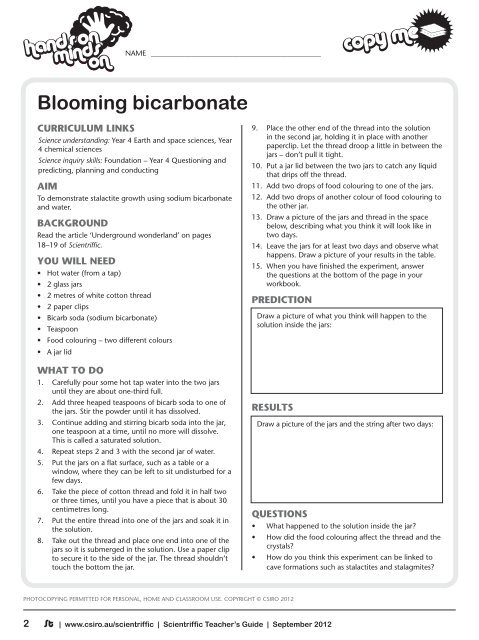Teachers Guide Scientriffic 81 - CSIRO
Teachers Guide Scientriffic 81 - CSIRO
Teachers Guide Scientriffic 81 - CSIRO
Create successful ePaper yourself
Turn your PDF publications into a flip-book with our unique Google optimized e-Paper software.
Blooming bicarbonate<br />
CurriCulum links<br />
Science understanding: Year 4 Earth and space sciences, Year<br />
4 chemical sciences<br />
Science inquiry skills: Foundation – Year 4 Questioning and<br />
predicting, planning and conducting<br />
Aim<br />
To demonstrate stalactite growth using sodium bicarbonate<br />
and water.<br />
BACkground<br />
Read the article ‘Underground wonderland’ on pages<br />
18–19 of <strong>Scientriffic</strong>.<br />
You will need<br />
• Hot water (from a tap)<br />
• 2 glass jars<br />
• 2 metres of white cotton thread<br />
• 2 paper clips<br />
• Bicarb soda (sodium bicarbonate)<br />
• Teaspoon<br />
• Food colouring – two different colours<br />
• A jar lid<br />
NAME ______________________________________________<br />
whAt to do<br />
1. Carefully pour some hot tap water into the two jars<br />
until they are about one-third full.<br />
2. Add three heaped teaspoons of bicarb soda to one of<br />
the jars. Stir the powder until it has dissolved.<br />
3. Continue adding and stirring bicarb soda into the jar,<br />
one teaspoon at a time, until no more will dissolve.<br />
This is called a saturated solution.<br />
4. Repeat steps 2 and 3 with the second jar of water.<br />
5. Put the jars on a flat surface, such as a table or a<br />
window, where they can be left to sit undisturbed for a<br />
few days.<br />
6. Take the piece of cotton thread and fold it in half two<br />
or three times, until you have a piece that is about 30<br />
centimetres long.<br />
7. Put the entire thread into one of the jars and soak it in<br />
the solution.<br />
8. Take out the thread and place one end into one of the<br />
jars so it is submerged in the solution. Use a paper clip<br />
to secure it to the side of the jar. The thread shouldn’t<br />
touch the bottom the jar.<br />
2 St | www.csiro.au/scientriffic | <strong>Scientriffic</strong> Teacher’s <strong>Guide</strong> | September 2012<br />
9. Place the other end of the thread into the solution<br />
in the second jar, holding it in place with another<br />
paperclip. Let the thread droop a little in between the<br />
jars – don’t pull it tight.<br />
10. Put a jar lid between the two jars to catch any liquid<br />
that drips off the thread.<br />
11. Add two drops of food colouring to one of the jars.<br />
12. Add two drops of another colour of food colouring to<br />
the other jar.<br />
13. Draw a picture of the jars and thread in the space<br />
below, describing what you think it will look like in<br />
two days.<br />
14. Leave the jars for at least two days and observe what<br />
happens. Draw a picture of your results in the table.<br />
15. When you have finished the experiment, answer<br />
the questions at the bottom of the page in your<br />
workbook.<br />
PrediCtion<br />
results<br />
PHoToCoPYING PERMITTED FoR PERSoNAL, HoME AND CLASSRooM USE. CoPYRIGHT © CSIRo 2012<br />
Draw a picture of what you think will happen to the<br />
solution inside the jars:<br />
Draw a picture of the jars and the string after two days:<br />
Questions<br />
• What happened to the solution inside the jar?<br />
• How did the food colouring affect the thread and the<br />
crystals?<br />
• How do you think this experiment can be linked to<br />
cave formations such as stalactites and stalagmites?
















